Potable Water Savings by Using Rainwater for Non-Potable Uses in Houses
Abstract
:1. Introduction
2. Objective
3. Method
3.1. Cities Chosen
| Cities | Countries |
|---|---|
| Alexandria | South Africa |
| Barcelona | Spain |
| Berlin | Germany |
| Dar-el-Beida | Algeria |
| Darwin | Australia |
| Encarnacion | Paraguay |
| Moscow | Russia |
| New York | USA |
| Paris | France |
| Quebec | Canada |
| Santarém | Brazil |
| Santo Amaro da Imperatriz | Brazil |
| Shanwei | China |
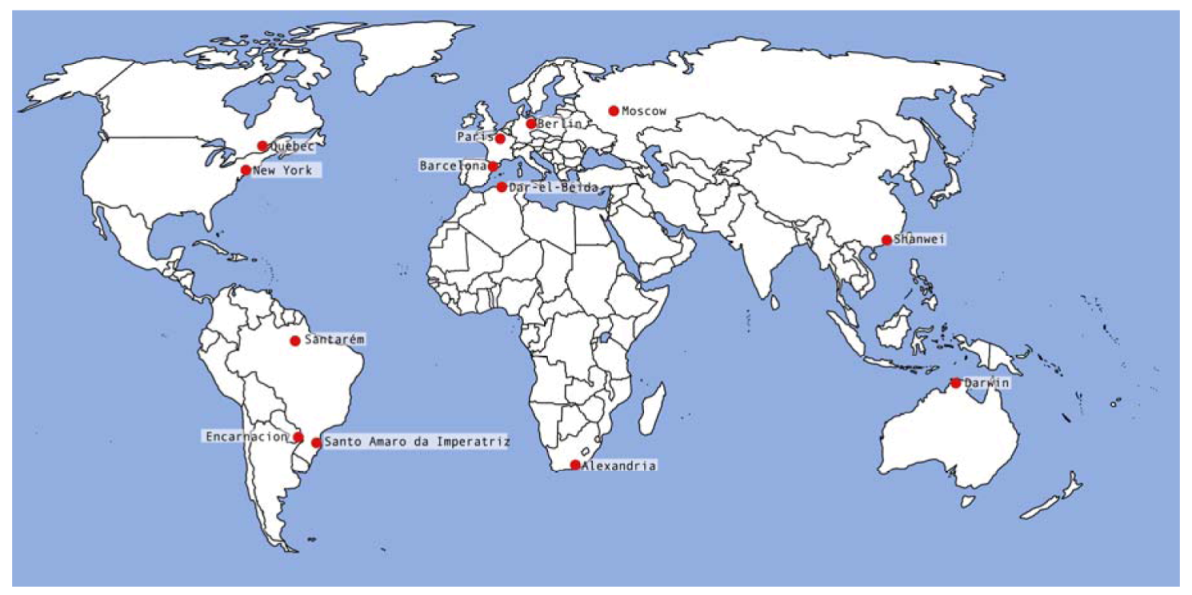
3.2. Rainfall Data
3.3. Computer Simulations
3.3.1. Catchment Surface Area
3.3.2. Potable Water Demand
3.3.3. Number of Residents
3.3.4. Rainwater Demand
3.3.5. Run-off Coefficient
3.3.6. Lower and Upper Rainwater Tanks
3.3.7. Ideal Capacity of the Lower Rainwater Tank
3.3.8. Correlations
4. Results
4.1. Rainfall
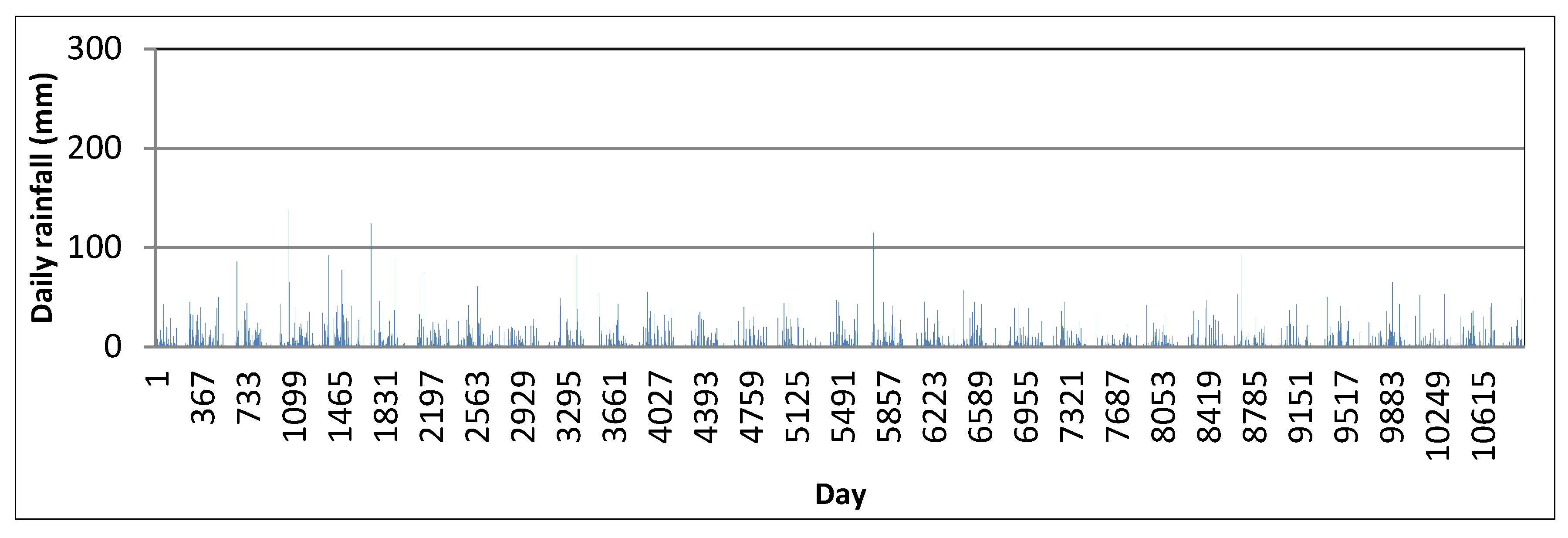


| City, Country | Rainfall time series | Average rainfall (mm/year) | |
| Begin–End | Years | ||
| Alexandria, South Africa | 01/01/1966–31/12/1995 | 30 | 591 |
| Barcelona, Spain | 01/01/1968–31/12/1997 | 30 | 634 |
| Berlin, Germany | 01/01/1972–31/12/2001 | 30 | 585 |
| Dar-el-Beida, Algeria | 01/01/1969–31/12/1998 | 30 | 654 |
| Darwin, Australia | 01/01/1972–31/12/2000 | 30 | 1839 |
| Encarnacion, Paraguay | 01/01/1970–31/12/1999 | 30 | 1848 |
| Moscow, Russia | 01/01/1970–31/12/1999 | 30 | 683 |
| New York, United States | 01/01/1980–31/12/2009 | 30 | 1265 |
| Paris, France | 01/01/1971–31/12/2000 | 30 | 650 |
| Quebec, Canada | 01/01/1965–31/12/1994 | 30 | 1219 |
| Santarém, Brazil | 01/01/1969–31/12/1998 | 30 | 2199 |
| Santo Amaro da Imperatriz, Brazil | 01/01/1969–31/12/1998 | 30 | 1761 |
| Shanwei, China | 01/01/1968–31/12/1997 | 30 | 1999 |
4.2. Computer Simulation Results
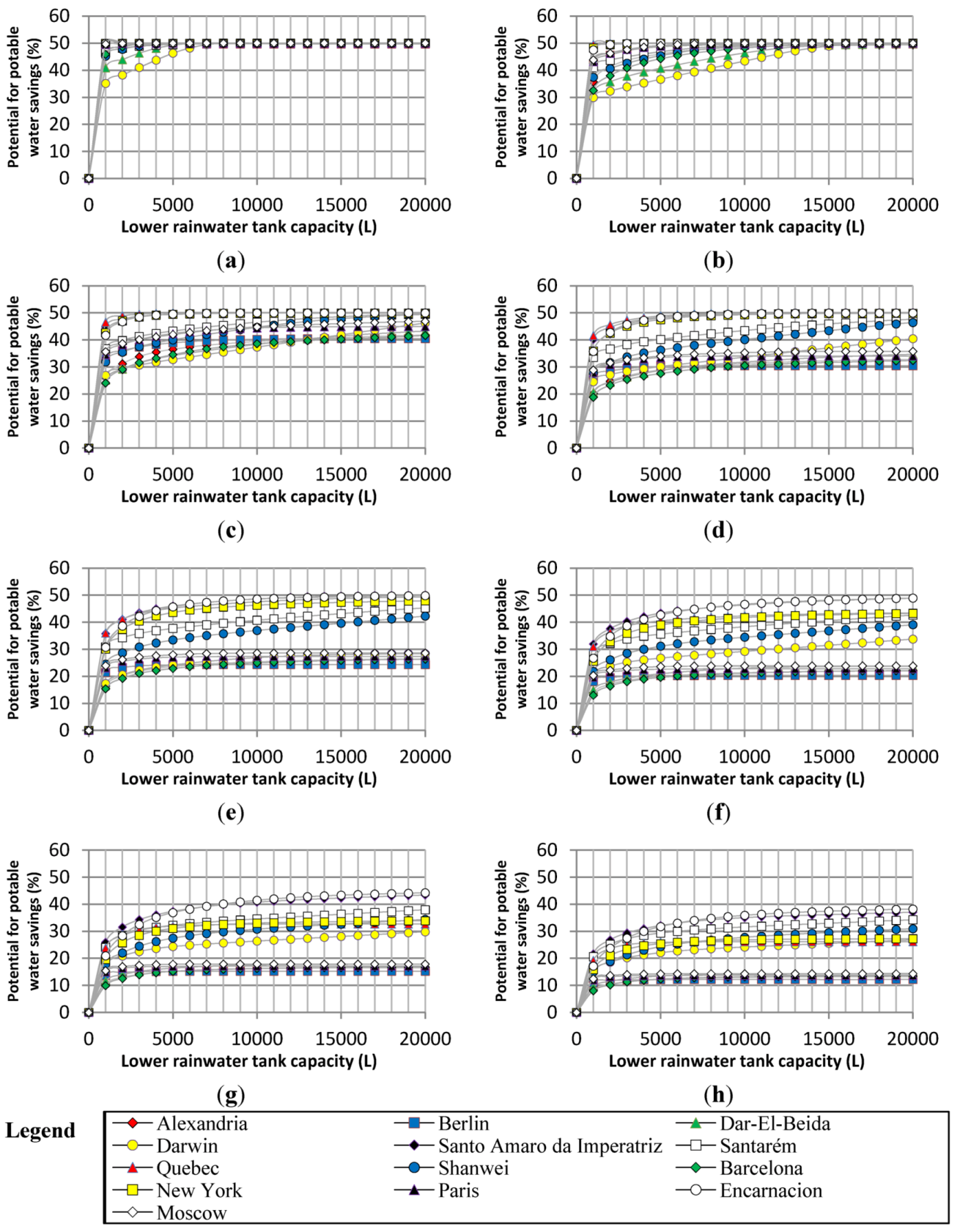
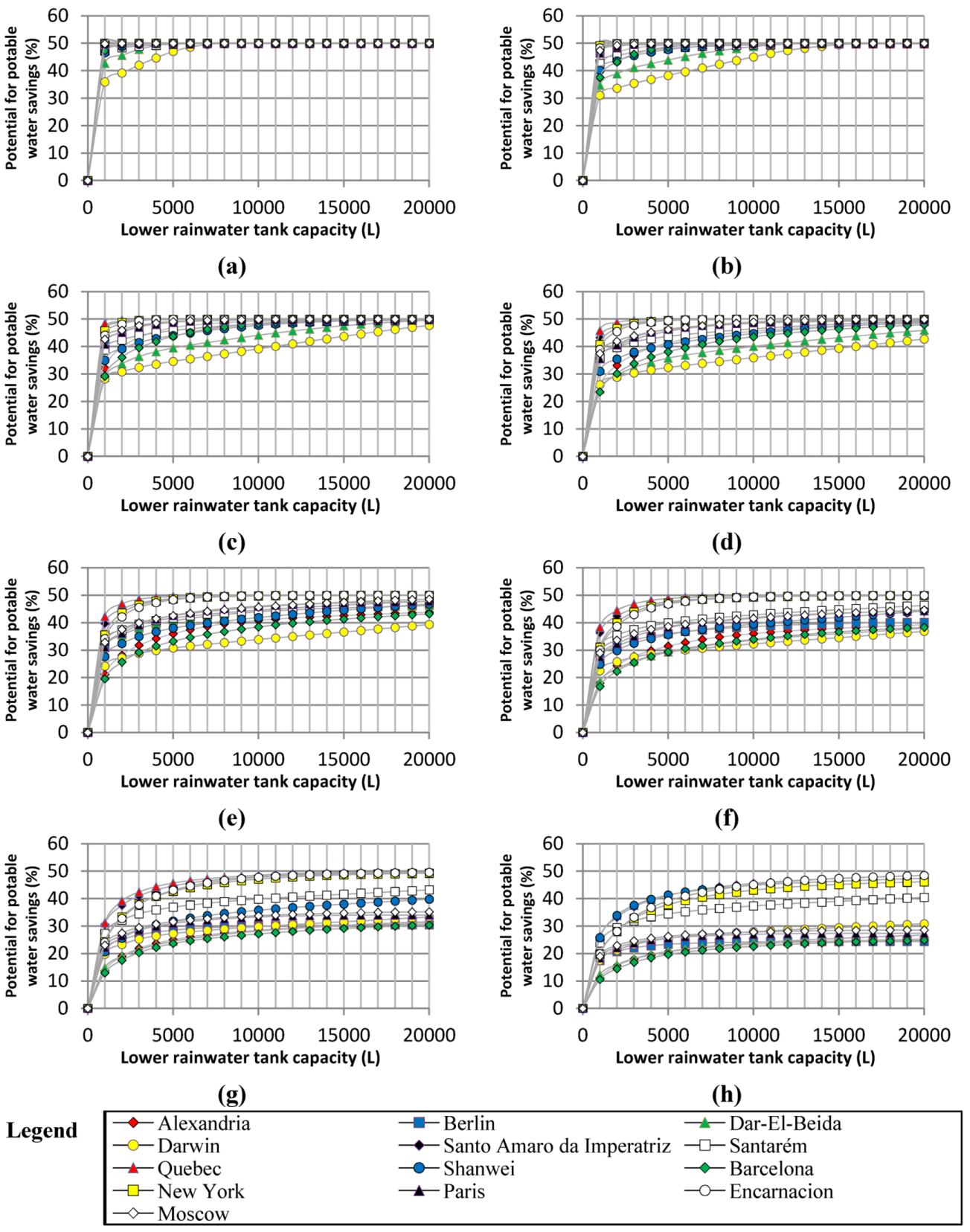
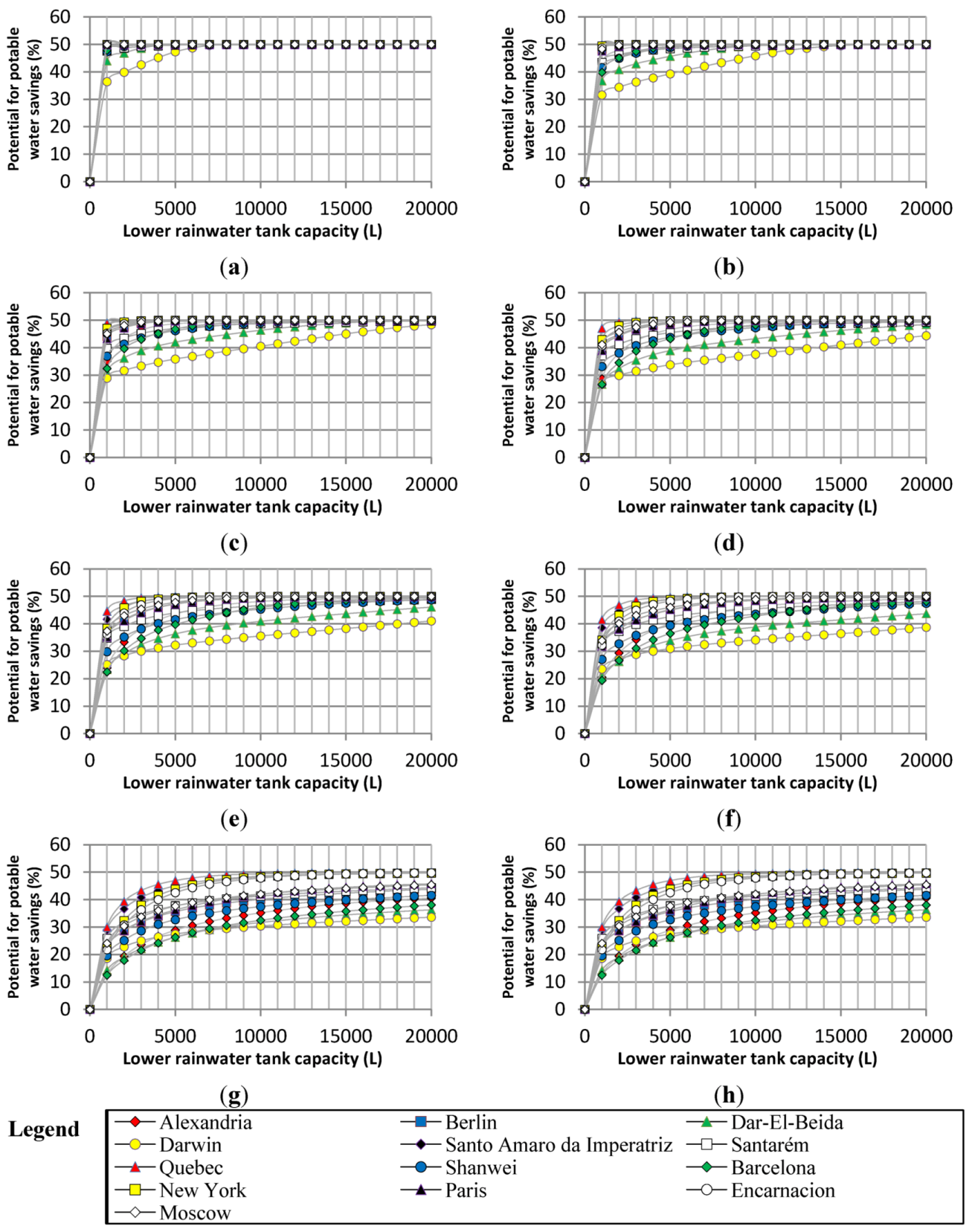
4.2.1. Potential for Potable Water Savings
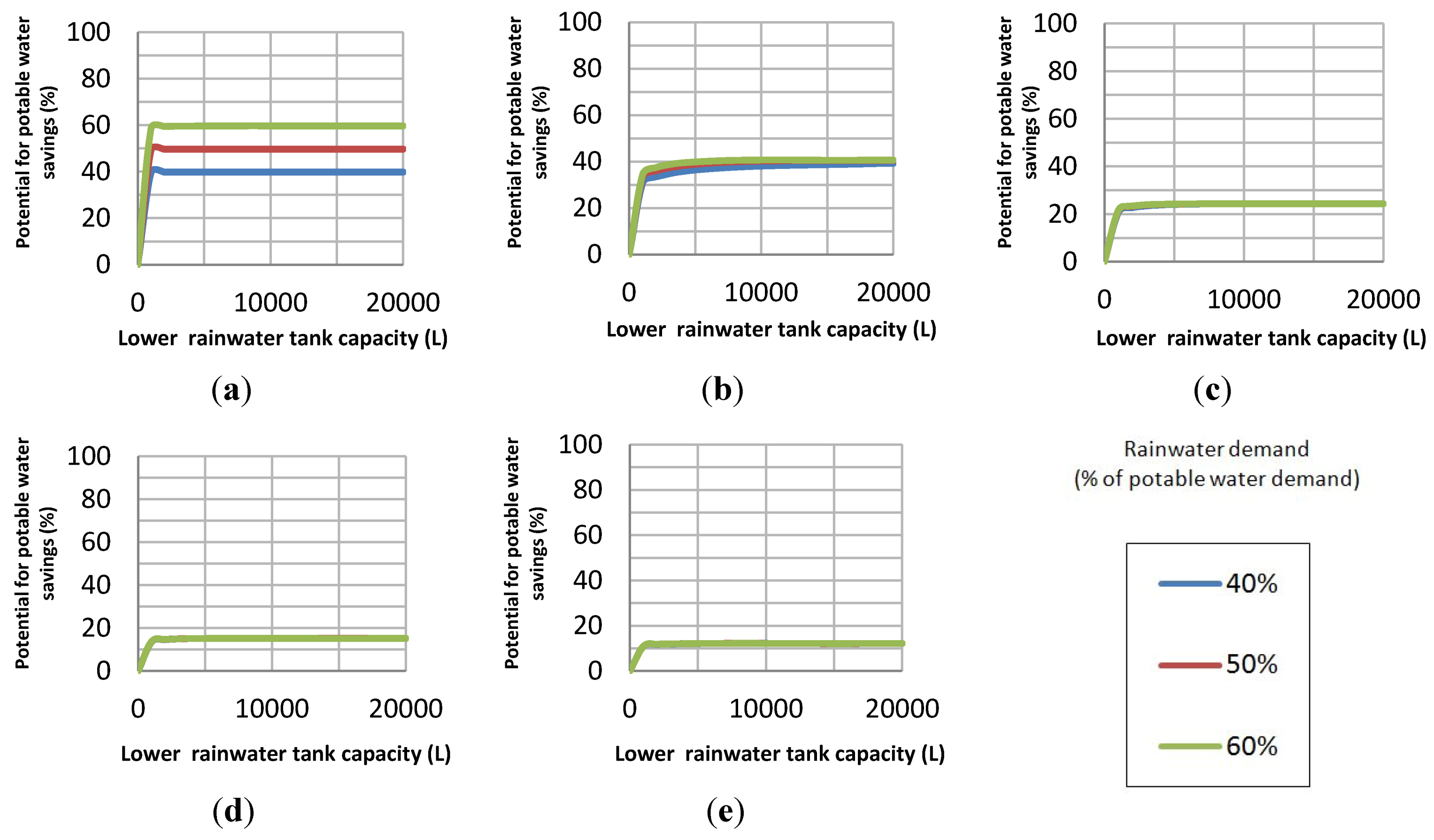
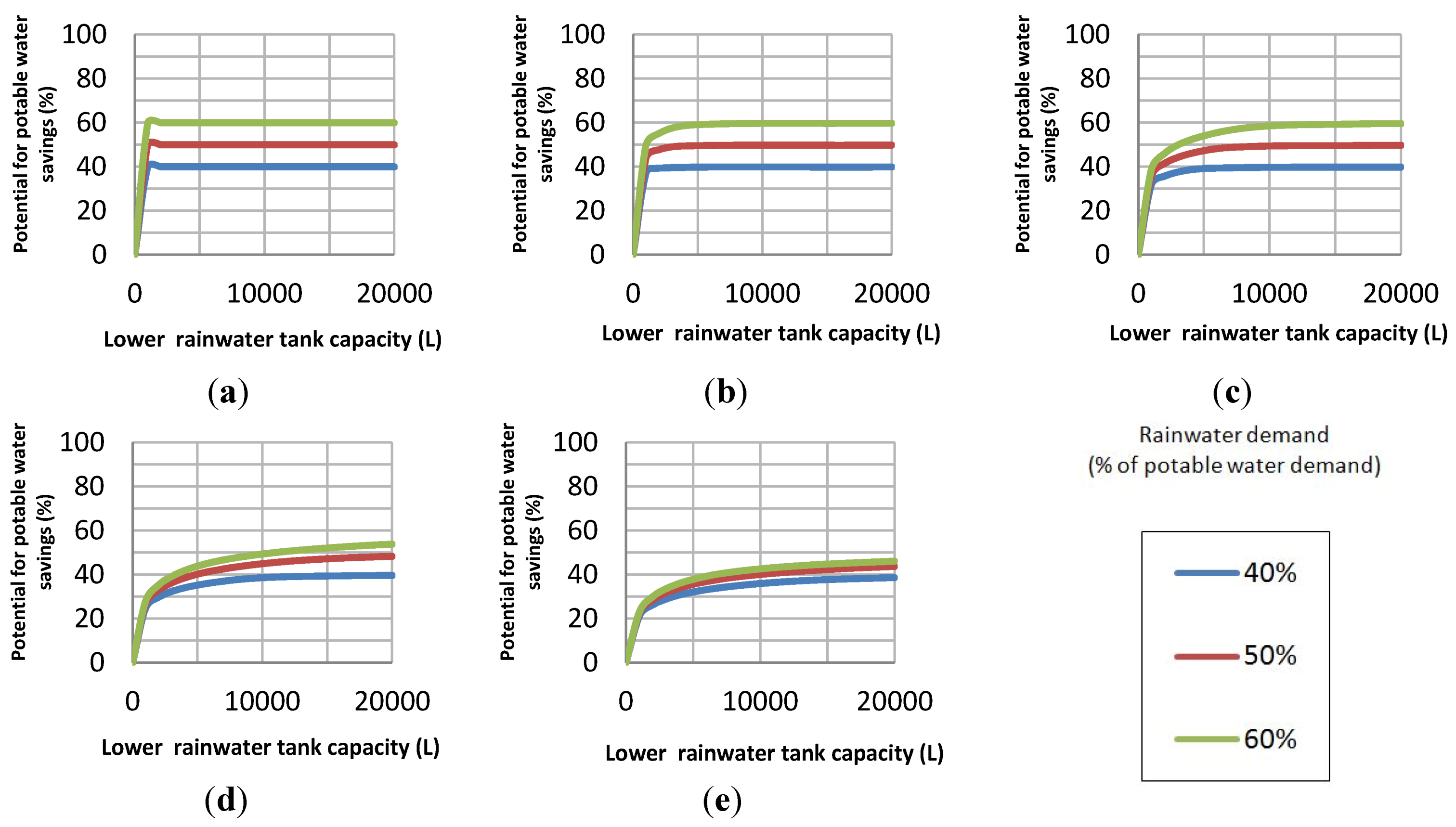



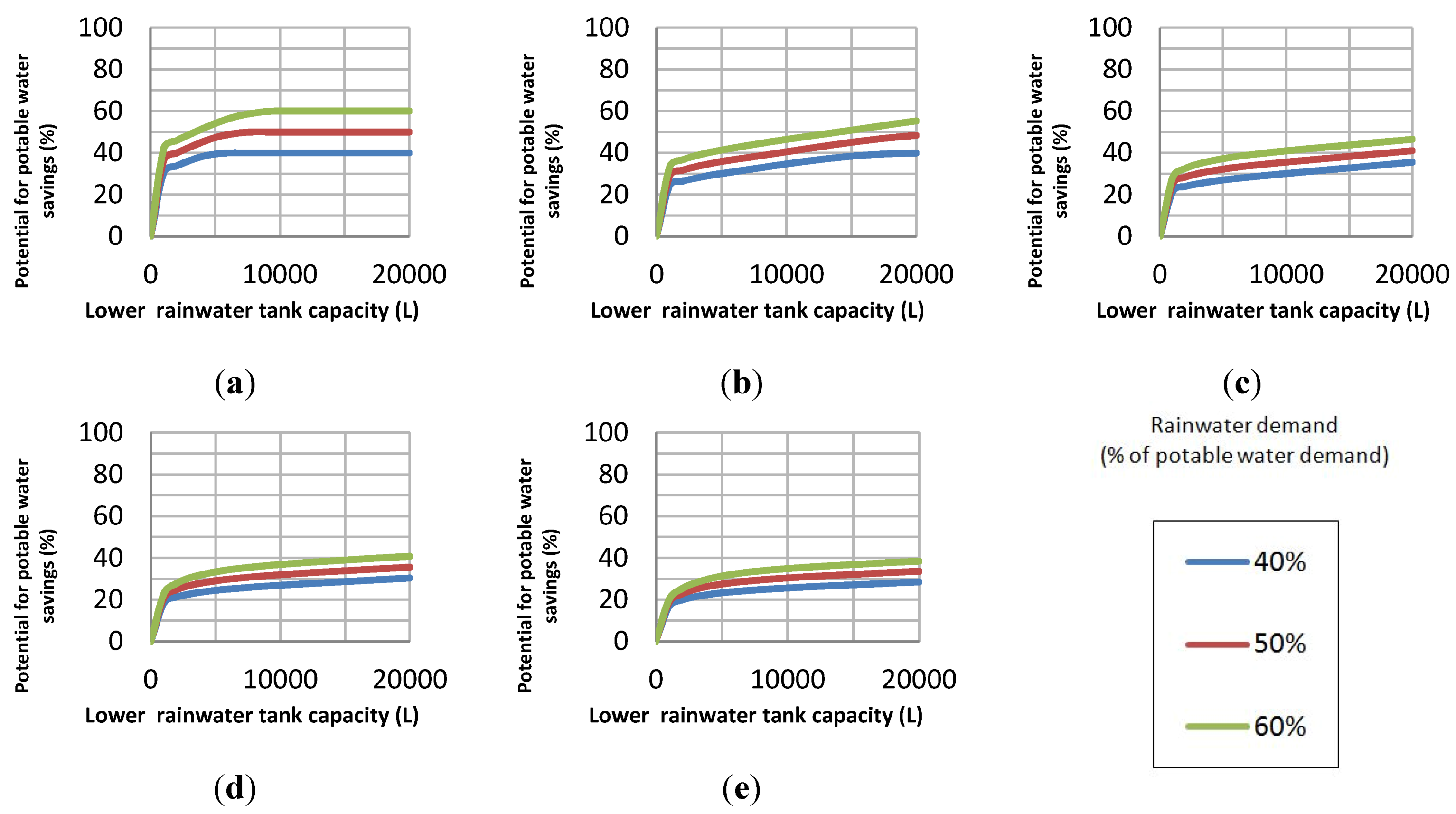
4.2.2. Rainwater Tank Capacity

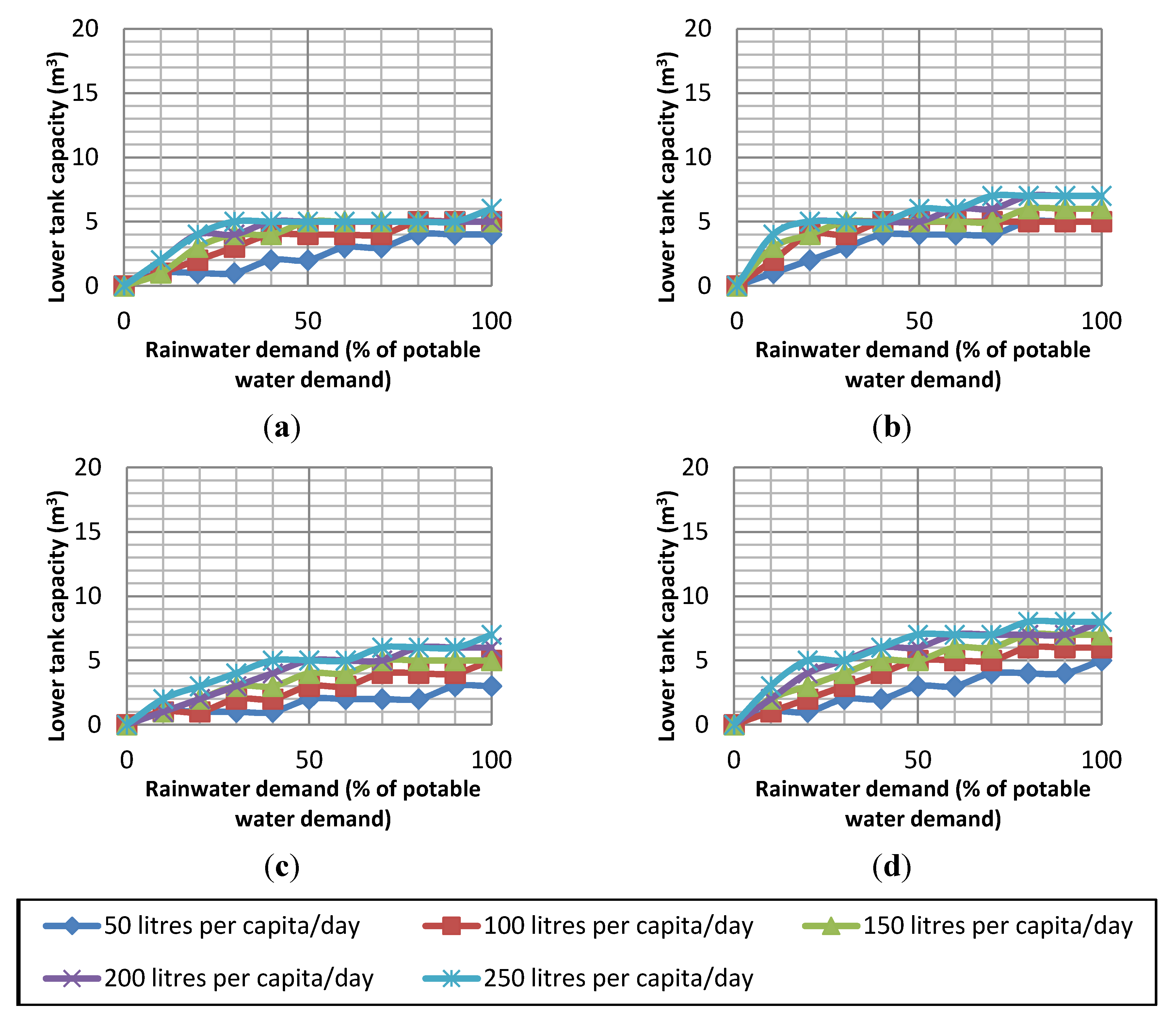
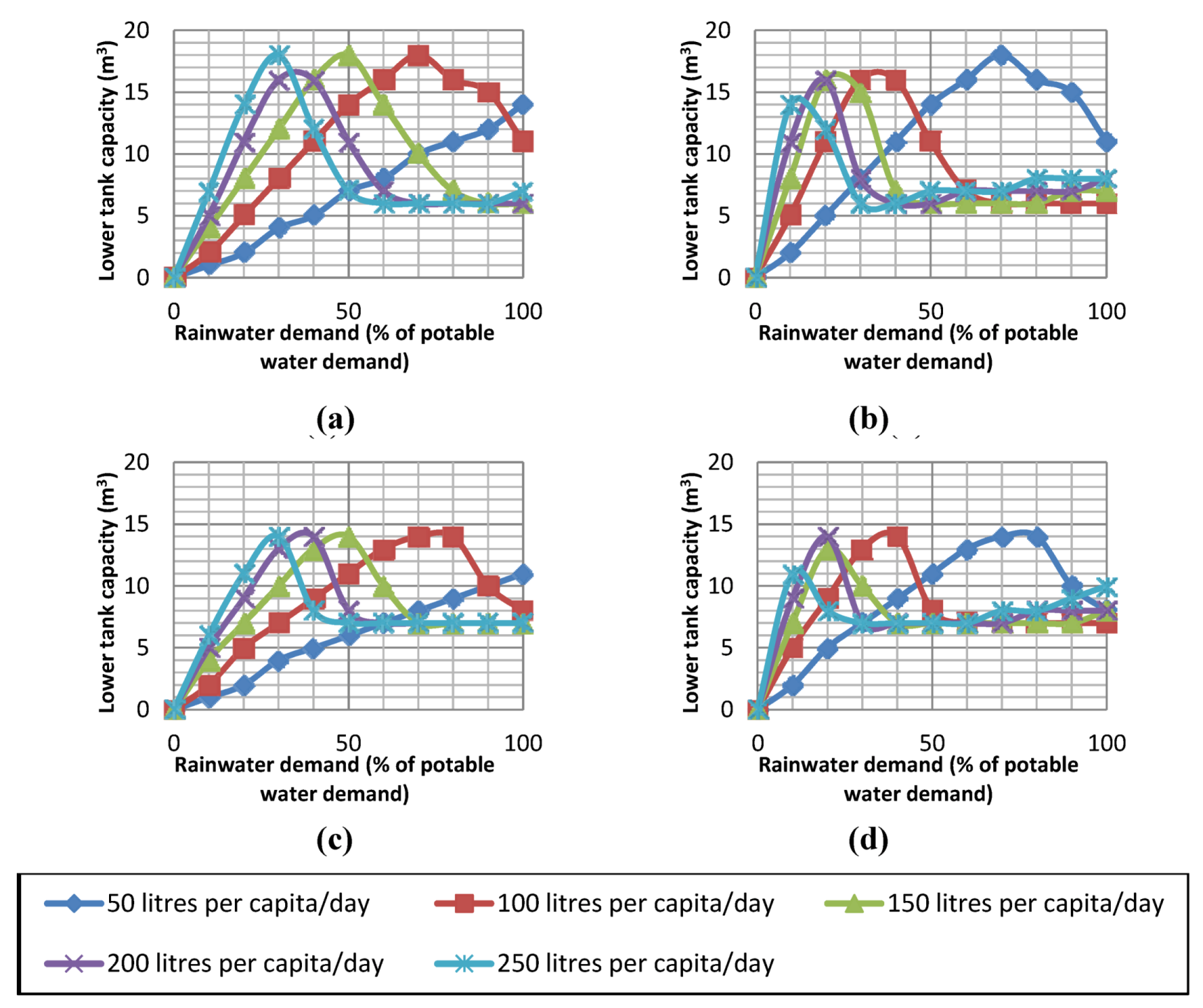
4.3. Correlations

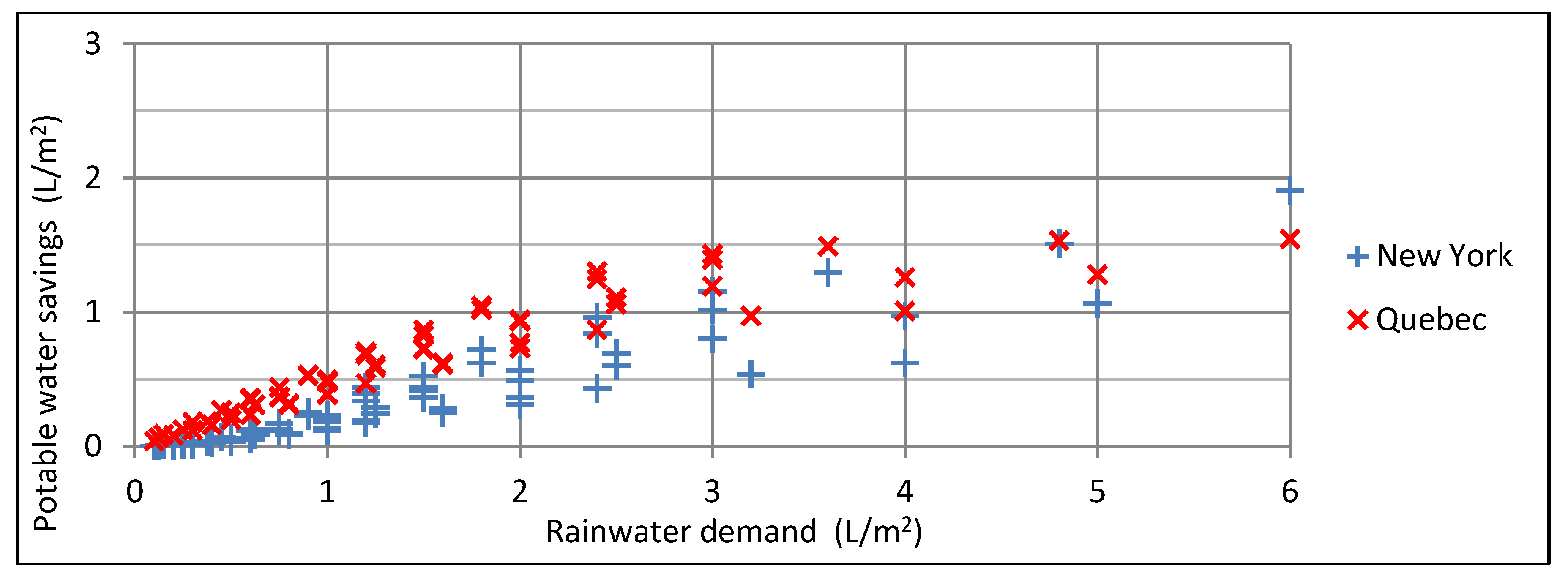


| City | Average rainfall (mm/year) | Lower rainwater tank capacity (m3) | ||||||
| Minimum and maximum capacity | Rainwater demand (L/m2) | |||||||
| 1 | 2 | 3 | 4 | 5 | 6 | |||
| Berlin | 585 | minimum | 3 | 3 | 3 | 3 | 2 | 2 |
| maximum | 8 | 5 | 4 | 3 | 2 | 2 | ||
| Alexandria | 591 | minimum | 5 | 6 | 6 | 6 | 6 | 6 |
| maximum | 11 | 9 | 8 | 6 | 6 | 6 | ||
| Barcelona | 634 | minimum | 7 | 8 | 6 | 6 | 6 | 6 |
| maximum | 12 | 9 | 9 | 6 | 6 | 6 | ||
| Paris | 650 | minimum | 3 | 4 | 3 | 3 | 3 | 3 |
| maximum | 8 | 6 | 5 | 3 | 3 | 3 | ||
| Dar-el-Beida | 654 | minimum | 8 | 8 | 7 | 7 | 6 | 5 |
| maximum | 10 | 10 | 9 | 7 | 6 | 5 | ||
| Moscow | 683 | minimum | 4 | 4 | 3 | 3 | 3 | 3 |
| maximum | 6 | 4 | 5 | 3 | 3 | 3 | ||
| Quebec | 1219 | minimum | 1 | 3 | 4 | 4 | 4 | 4 |
| maximum | 4 | 6 | 7 | 4 | 4 | 4 | ||
| New York | 1265 | minimum | 2 | 4 | 6 | 6 | 5 | 5 |
| maximum | 6 | 7 | 9 | 6 | 5 | 5 | ||
| Darwin | 1839 | minimum | 7 | 6 | 6 | 6 | 7 | 7 |
| maximum | 14 | 12 | 7 | 6 | 7 | 7 | ||
| Shanwei | 1999 | minimum | 6 | 7 | 7 | 8 | 9 | 9 |
| maximum | 8 | 8 | 9 | 8 | 9 | 9 | ||
| Santo Amaro da Imperatriz | 1761 | minimum | 2 | 4 | 6 | 7 | 7 | 7 |
| maximum | 5 | 6 | 8 | 7 | 7 | 7 | ||
| Encarnacion | 1848 | minimum | 2 | 4 | 7 | 8 | 8 | 8 |
| maximum | 6 | 8 | 10 | 8 | 8 | 8 | ||
| Santarém | 2199 | minimum | 4 | 5 | 5 | 5 | 6 | 6 |
| maximum | 6 | 6 | 6 | 5 | 6 | 6 | ||
5. Conclusions
6. Limitations
- (1) The demands considered were obtained by averaging collected data from the existing literature. For better accuracy, the ideal would be to obtain empirical data from drinking water demands for each city and social class;
- (2) Reliable daily rainfall data were not available for some cities of great importance or with serious problems of lack of water;
- (3) Although it is not the focus of the work, an investment feasibility analysis could give more reliability to the results;
- (4) Other parameters that influence the potential for potable water savings could have been considered, such as water restrictions, household behavior, water-efficient household stock, among others.
References
- Shiklomanov, I.A. A New Appraisal and Assessment for the 21st Century. World Water Resources; United Nations Educational, Scientific and Cultural Organization: St Petersburg, Russia, 1998. [Google Scholar]
- Ghisi, E. Potential for potable water savings by using rainwater in the residential sector of Brazil. Build. Environ. 2005, 41, 1544–1550. [Google Scholar] [CrossRef]
- Gulyani, S.; Talukdar, D.; Kariuk, M. Water markets, household demand and the poor in urban Kenya. Urban Stud. 2005, 42, 1247–1274. [Google Scholar] [CrossRef]
- May, S. Estudo da Viabilidade do Aproveitamento de Água de Chuva Para Consumo não Potável em Edificações [Study on the Feasibility of Rainwater Harvesting for Non-Potable Uses in Buildings].
- Handia, L.; Tembo, J.M.; Mwiindwa, C. Potential of rainwater harvesting in urban Zambia. Phys. Chem. Earth 2003, 28, 893–896. [Google Scholar] [CrossRef]
- Villarreal, E.L.; Dixon, A. Analysis of a rainwater collection system for domestic water supply in Ringdansen, Norrköping, Sweden. Build. Environ. 2005, 40, 1174–1184. [Google Scholar]
- Deng, S. Energy and water uses and their performance explanatory indicators in hotels in Hong Kong. Energy Build. 2003, 35, 775–784. [Google Scholar] [CrossRef]
- Cheng, C.L.; Hong, Y.T. Evaluating water utilization in primary schools. Build. Environ. 2004, 39, 837–845. [Google Scholar] [CrossRef]
- Eroksuz, E.; Rahman, A. Rainwater tanks in multi-unit buildings: A case study for three Australian cities. Res. Conserv. Recycl. 2010, 54, 1449–1452. [Google Scholar] [CrossRef]
- Zaizen, M.; Urakawa, T.; Matsumoto, Y.; Takai, H. Case study: The collection of rainwater from dome stadiums in Japan. Urban Water 1999, 1, 355–359. [Google Scholar]
- Marinoski, A.K.; Ghisi, E. Aproveitamento de água pluvial para usos não potáveis em instituição de ensino; estudo de caso em Florianópolis-SC (Rainwater Harvesting for non-potable uses in educational institutions: A case study in Florianópolis-SC). Ambiente Construído 2008, 2, 67–84. [Google Scholar]
- Abdulla, F.A.; Al-Shreef, A.W. Roof rainwater harvesting systems for household water supply in Jordan. Desalination 2009, 1, 195–207. [Google Scholar]
- Fewkes, A. The use of rainwater for WC flushing: the field testing of a collection system. Build. Environ. 1999, 34, 765–772. [Google Scholar] [CrossRef]
- Slys, D. Potential of rainwater utilization in residential housing in Poland. WaterEnviron. J. 2009, 23, 318–325. [Google Scholar]
- Imteaz, M.A.; Shanableh, A.; Rahman, A.; Ahsan, A. Optimisation of rainwater tank design from large roofs: A case study in Melbourne, Australia. Res. Conserv. Recycl. 2011, 55, 1022–1029. [Google Scholar] [CrossRef]
- Global Climate Observing System (GCOS) . Available online: http://www.ncdc.noaa.gov/oa/climate/ghcn-daily/index.php?name=data (accessed on 20 May 2011).
- Ghisi, E.; Cordova, M.M.; Rocha, V.L. Netuno 2.1. Computer Programme; School of Civil Engineering, Federal University of Santa Catarina: Florianópolis, Brazil, 2009. Available online: http://www.labeee.ufsc.br/ (accessed on 10 May 2009).
- Ghisi, E. Parameters influencing the sizing of rainwater tanks for use in houses. Water Res. Manag. 2010, 24, 2381–2403. [Google Scholar] [CrossRef]
- Rocha, V.L. Validação do algoritmo do programa Netuno para avaliação do potencial de economia de água potável e dimensionamento de reservatórios de aproveitamento de água pluvial em edificações [Validation of the Algorithm of the Netuno Computer Programme to Assess the Potential for Potable Water Savings and Sizing of Rainwater Tanks for Rainwater Usage in Buildings].
- Chiu, Y.; Chao Hsien, Y.; Liang-Ching, C. Optimizing rainwater harvesting systems as an innovative approach to saving energy in hilly communities. Renew. Energy 2009, 34, 492–498. [Google Scholar] [CrossRef]
- Tomaz, P. Economia de Água para Empresas e Residências–Um Estudo Atualizado sobre o Uso Racional da Água. [Water Saving for Business and Residences–An Updated Study on the Rational Use of Water]; Navegar Editora: São Paulo, Brazil, 2001. [Google Scholar]
- Tomaz, P. Previsão de Consumo de Água—Interface das Instalações Prediais de Água e Esgoto com os serviços Públicos. [Water Consumption Forecast—Interface Building Installation of Water and Sewerage with Public Service]; Navegar Editora: São Paulo, Brazil, 2001. [Google Scholar]
- Tomaz, P. Aproveitamento de Água de Chuva—Para Áreas Urbanas e Fins não Potáveis. [Use of Rainwater—For Urban Areas and non Potable Purposes]; Navegar Editora: São Paulo, Brazil, 2003. [Google Scholar]
- Marinoski, A.K. Aproveitamento de Água Pluvial Para Usos não Potáveis em Instituições de Ensino: Estudo de Caso em Florianópolis-SC. [Rainwater Harvesting for Non-Potable Uses in Educational Institutions: A Case Study in Florianópolis-SC.]; School of Civil Engineering, Federal University of Santa Catarina: Florianópolis, Brazil, 2007. [Google Scholar]
- Ghisi, E.; Ferreira, D.F. Potential for potable water savings by using rainwater and greywater in a multy-storey residential building in southern Brazil. Build. Environ. 2007, 42, 2512–2522. [Google Scholar] [CrossRef]
- Imteaz, M.A.; Rahman, A.; Ahsan, A. Reliability analysis of rainwater tanks: A comparison between South East and Central Melbourne. Res. Conserv. Recycl. 2012, 66, 1–7. [Google Scholar] [CrossRef]
© 2012 by the authors; licensee MDPI, Basel, Switzerland. This article is an open-access article distributed under the terms and conditions of the Creative Commons Attribution license (http://creativecommons.org/licenses/by/3.0/).
Share and Cite
Souza, E.L.; Ghisi, E. Potable Water Savings by Using Rainwater for Non-Potable Uses in Houses. Water 2012, 4, 607-628. https://doi.org/10.3390/w4030607
Souza EL, Ghisi E. Potable Water Savings by Using Rainwater for Non-Potable Uses in Houses. Water. 2012; 4(3):607-628. https://doi.org/10.3390/w4030607
Chicago/Turabian StyleSouza, Eduardo Leite, and Enedir Ghisi. 2012. "Potable Water Savings by Using Rainwater for Non-Potable Uses in Houses" Water 4, no. 3: 607-628. https://doi.org/10.3390/w4030607





